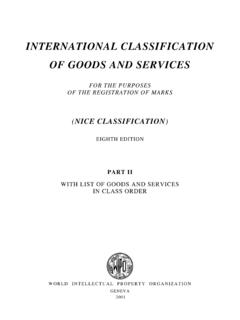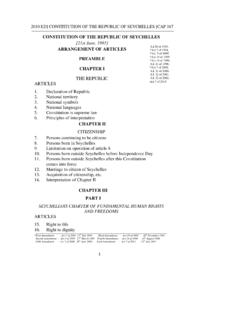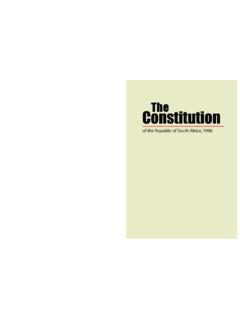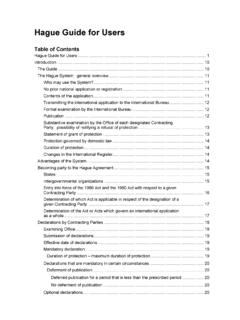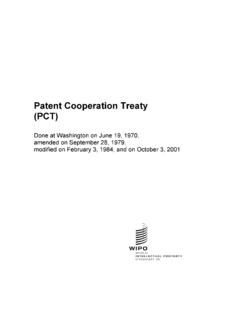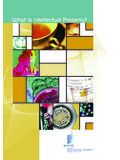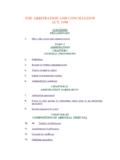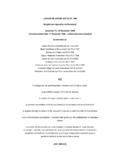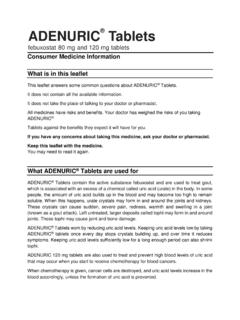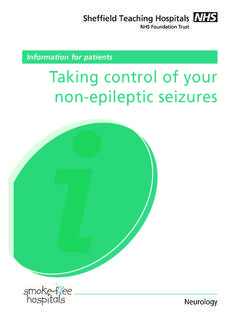Transcription of Legal Pitfalls in Taking or Using Photographs of …
1 Legal Pitfalls in Taking or Using Photographs of Copyright Material, Trademarks and People Lien Verbauwhede, Consultant, SMEs Division, WIPOiIntroductionPhotographers and users of Photographs face certain risks when Taking and publishing Photographs . This article provides an overview of the general Legal principles applicable to Taking Photographs of copyright works, trademarks and people. It is written for photographers. However, most lawsuits are filed against the person who usesa photograph rather than against the photographer. All businesses that use Photographs ( , in their advertising, product packaging, website or business brochure), therefore, should be aware of potential liabilities. It is true that the applicable laws of countries are, broadly speaken, similar. Yet, there are important It is impossible to deal with here every law applicable to photographyiii, or to discuss the relevant laws of all the countries worldwide.
2 This article, therefore, cannot be a substitute for Legal advice in a particular business context. To know how the relevant laws apply to specific facts and circumstances, please seek advice from a competent local lawyer. 1. MAKING PHOTOS OF COPYRIGHT MATERIALA dvertising, fashion, interior design and lifestyle photographers frequently include paintings, sculptures, craft items, architectural works, jewelry, clothing, toys or other artistic works in their Photographs . Often, such items are protected by copyright. Only the owner of a copyright has the exclusive right to reproduce the copyright work. Photographing a copyright work amounts to reproducing it. Therefore, before you take a photo of any copyright work, you need the prior permission of the copyright owner. Photographers who infringe a copyright may be required to compensate for the economic loss, that is, to pay the damages they have caused and sometimes also other expenses, such as Legal When do you need permission from the copyright owner?
3 The response to this question depends on your answers to a series of questions about the subject or object to be photographed, and the use to which the photograph would be put Will the photograph contain an object that is protected by copyright?Be warned: Copyright law protects a wide range of different types of material. Examples of copyright works that are routinely reproduced in Photographs are:1. Literary works (such as books, newspapers, catalogs, magazines);2. Artistic works (such as cartoons, paintings, sculptures, statues, architectural works, computer and laser artwork);23. Photographic works (such as photos, engravings, posters);4. Maps, globes, charts, diagrams and technical drawings; 5. Advertisements, commercial prints, billboards and labels;6. Motion pictures (such as films, documentaries, television advertisements);7.
4 Dramatic works (such as dance, plays, mime); and8. Works of applied art (such as artistic jewelry, wallpaper, carpets, toys and fabrics). Has the term of the copyright expired?You don t need permission to photograph a work if its copyright term has expired. For most works, and in most countries, copyright protection lasts for the lifetime of the author (artist) plus an additional period of at least 50 years. In a number of countries, this period is even longer. For example, 70 years after the death of the author in Europe, the United States of America and several other several authors are involved, then the term of protection is calculated from the death of the last surviving author. Note also that special rules may apply to certain specific kinds of works. It is, therefore, a good practice to check the applicable copyright Will you use a substantial part of the work?
5 Do not think that you don t need to worry about copyright issues if you include only a partof a copyright work in your photograph , or if this work occupies only a very small amount of space in your photograph . In general, you need a permission if the part of a copyright work so used is considered to be a substantial part of that copyright work. A substantial part is an important, essential or distinct part. However, there is (and can be) no general rule on how much of a work may be used without prior permission. Often, the quality of what is used may be more important than how much is used. The determination of a substantial part is done on a case-by -case basis, depending on the particular facts and circumstances. Example: The Son of Man, a painting from Ren Magritte, depicts a man whose face is obscured by an apple.
6 If you would only use the face with the apple, you may still require permission. While, in fact, this is only a small part of the total painting, it is seen as a vital or recognizable part of Magritte s painting. Because there is no hard-and-fast rule, relying on the defense that you are Using only a non substantial part of a work may be dangerous. The best advice is to ask prior permission from the copyright owner if you are in Will you do something that actually constitutes an act which the copyright owner has the exclusive right to make?As indicated earlier, photographing a copyright work is considered a way of reproducing the work, and this is an act which the copyright owner has the exclusive right to do. This is why you may need to get prior permission to include a copyright work in your shot.
7 Some other activities that only the copyright owner has the exclusive right to do (and for which you may need permission) are:3-Making prints of a work, scanning it into digital form, photocopying it, copying digital works, etc.; -Making a collage from several different Photographs or images;-Adding new artistic elements to an existing work ( , colorizing a black and white picture);-Photographing someone s work and then displaying the photo to the public ( , exhibiting the photo in a gallery, supplying copies to the public in postcard form, putting it on a website, sending it to customers via e-mail, etc.). Does a special exception apply?Reckoning with the above, copyright considerations would place enormous restraints on photography since it is impossible to avoid including copyright items in many Photographs .
8 Fortunately, there are several Legal exceptions that allow you to reproduce copyright works (in a photograph ) without permission. However, the exceptions vary from country to country and are not always easy to determine. Exceptions are generally covered by what are know as limitations or exceptions to copyright which are specifically mentioned in the national copyright law, or by relying on the concept of fair use or fair dealing. viIt is not the purpose of this article to provide a full list of all exceptions that you could benefit from. Rather, I explain hereunder some of the most common situations in which you may be free to photograph copyright material by an exception from copyright protection. Taking photos of buildings Architectural works are protected by copyright to some degree, but in most countries you may photograph a building, if the building is located in a public place or is visible from a public place.
9 You may also publish and distribute the photo without Taking photos of copyright works in public placesIn some countries, you don t need permission to photograph certain artistic works that are permanently displayed in a public place (for example, in a park or on the street). You can also publish and commercialize the photograph without infringing copyright. However, this exception applies only:-To certain types of works: usually, only to three-dimensional works, such as sculptures and craft. So, you may still need prior permission to take a photo of a painting or a mural in a public place;-If the work is displayed in public: to photograph a sculpture in a private house, a permission will usually be required; and-If the work is displayed in public permanently: if you want to photograph a sculpture which is only temporarily sited in a public place, you would usually need permission.
10 Taking photos to accompany news reportsUsually, copyright works may be used for the purpose of reporting a news. For example, you could take a photo of a sculpture which won a major art prize, if that photo is to be used in a news report on TV or in a media article discussing or announcing the award-winner. 4 However, you will usually have the obligation to identify the name of the creator, and maybe also the name or title of the work that you have captured in your photo. Taking photos to accompany a review or critiqueIn most countries, copyright material may be used for criticism or review. For example, if you are Taking photos of cartoons for a book which reviews, critiques or analyses the works. Just like for the exception of news reporting, you will usually be required to identify the copyright work and the name of the artist.

